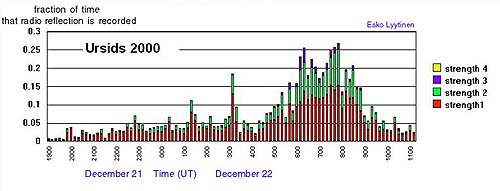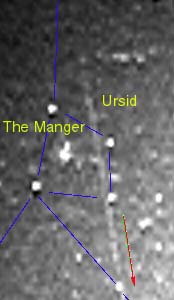|
Leonid MAC |
| home |
| View the shower |
| Mission Brief |
| Science Update |
| Media Brief |
| links |
LEONID DAILY NEWS: December 23, 2000

This record of total meteor activity was obtained by Esko Lyytinen using forward
meteor scatter. Click on the graph for an overview of the reflections.
A similar record by Ilkka Yrjola of Kuusankoski, Finland, is shown
below. Both data sets clearly demonstrate the Ursid outburst.
URSID OUTBURST CONFIRMED
Radio forward meteor scatter observations - Finland.
The Ursid shower did flare up significantly last night between 5 UT and 9:30 UT,
with a peak around 7:20ÿý10 UT according to
foreward scatter observations by Esko Lyytinen (shown above). The forward
scatter technique counts meteors by listening to reflected signals from faraway
radio and tv transmitters.
Ilkka Yrjola of Kuusankoski, Finland, reports similar results. His counts (right)
are shown after subtraction of the daily sporadic background. Yrjola is located
about 100 km from Lyytinen and collects reflections in the opposite direction.
Other confirmations from radio-MS observations were received from Sadao Okamoto, Sabae City,
Japan, Masayoshi Ueda of Japan,
Ton Schoenmaker of Roden in the Netherlands, and Wayne Itano of Boulder, CO.
Video and visual observations - California.
The shower was observed by us from California, using video imaging and
spectroscopy techniques. Present were Peter Jenniskens, Ming Li and Duncan
McNeill at a site near Parkfield, and Pete Gural, Mike Koop, Mike Wilson, and
Chris Angelos at the San Antonio Lake campground near King City. GlobalStar
provided a satelite telephone link.
Local weather allowed observations between about
5:30 and 11:20 UT. Six intensified cameras at each site
recorded the variation of flux and Ursid light curves.
Some very minimal (!) visual observations taken in between operations of equipment
are reported below and suggest a ZHR of about 50 shortly after the peak. This compares to
a peak ZHR of 80 for the Perseid shower in summer.
We've analysed the first video tapes of our observations in California
and find the (preliminary) rate of Ursids shown here. These were gathered by Peter Gural
and Peter Jenniskens from a visual scan of the tapes of
three of our intensified video camera's at Parkfield. 8 more cameras to go.
We also detected at least one Ursid spectrum at 08:24:57 UT, covering the
wavelength range from about 400 to 850 nm, the meteor of which was imaged
from both observing sites. 19 double station Ursids thus far after comparisson
with part of the tapes from an aligned intensified video camera at San Antonio
Lake.
The peak time and duration of the shower appear to be very similar to our
predictions , with a peak time at 7:29 UT (1405 trail) and a
possible contribution from the 1392 trail at 8:38 UT. The observed maximum is in between.
Further confirmation of the
models and information on the relative contributions of both trails will
follow from further analysis of the observational data.
Left: A "Christmassy" Ursid meteor passes M44, the Beehive cluster, also called the Manger,
in the constellation Cancer. Image courtesy: Peter Jenniskens, California
US and Canadian observers were best located for the event, although European observers
Marco Langbroek of the Netherlands and Sirko Molau and Rainer Alt of Germany
report observing the
onset of the shower
at 5-6:15 UT, at which time the ZHR was about 20. Japenese observers witnessed the final
part of the profile.
Among scientific efforts, Bob Hawkes from Mount Allison University in New Brunswick, Canada,
reports video imaging during relatively low Ursid rates between 4:15 and 6:00 UT,
prior to the peak, after which clouds interfered with further observations.
Dec. 23 - Ursid outburst confirmed Dec. 18 - Dec 22 Ursid outburst Nov. 20 - A bacterial fingerprint? Nov. 15 - HCN disappears mysteriously Nov. 14 - Meteor shower from space Nov. 13 - Organic fingerprint Nov. 12 - Train airglow chemistry Nov. 11 - Hard bits and persisting glows Nov. 10 - Meteoroid debris detected Nov. 09 - New meteor picture Nov. 08 - Spin city Nov. 07 - Meteors affect atmospheric chemistry Nov. 06 - Listen to this! Nov. 04 - Fear of heights? Nov. 03 - The pale (infra-red) dot Nov. 02 - Twin showers Nov. 01 - Leonids approaching Earth Oct. 31 - Prospects for Moon Impact Studies Oct. 30 - Comet dust crumbled less fine Today's news
| ||




